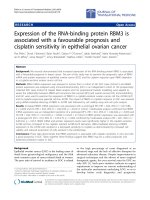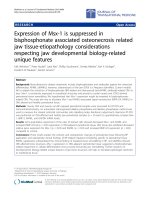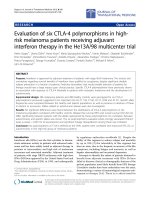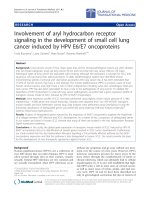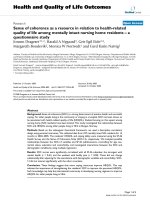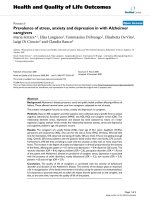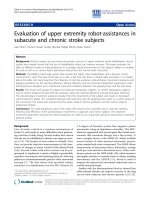báo cáo hóa học:" Expression of interleukin-1 (IL-1) ligands system in the most common endometriosis-associated ovarian cancer subtypes" pdf
Bạn đang xem bản rút gọn của tài liệu. Xem và tải ngay bản đầy đủ của tài liệu tại đây (990.85 KB, 8 trang )
RESEARC H Open Access
Expression of interleukin-1 (IL-1) ligands system
in the most common endometriosis-associated
ovarian cancer subtypes
Mamadou Keita
1
, Paul Bessette
1
, Manuella Pelmus
2
, Youssef Ainmelk
1
, Aziz Aris
1,3*
Abstract
Objectives: Endometrioid carcinoma of the ovary is one of the most types of epithelial ovarian cancer associated
to endometrioisis. Endome trioid tumors as well as endometriotic implants are characterized by the presence of
epithelial cells, stromal cells, or a combination of booth, that resemble the endometrial cells, suggesting a possible
endometrial origin of these tumors. Pro-inflammatory cytokines, including interleukin-1 (IL-1) have been reported to
be involved in both endometriosis and ovarian carcinogenesis. The major objective of this study was to determine
the level expression of IL-1 ligands system (IL-1a, IL-1b and IL-1RA) in the most common subtypes of ovarian
cancer cells compared to endometrial cells.
Methods: We used primary endometrial cells, endometrial cell line RL-952 and different subtypes of epithelial
ovarian cancer cell lines including TOV-112D (endometrioid), TOV-21G (clear cell) and OV-90 (serous).
Immunofluorescence and real-time PCR analysis were used respectively for detecting IL-1 ligands at the levels of
cell-associated protein and mRNA. Soluble IL-1 ligands were analyzed by ELISA.
Results: We demonstrated that IL-1 ligands were expressed by all endometriosis-associated ovarian cancer
subtypes and endometrial cells. In contrast to other cancer ovarian cells, endometrioid cells exhibit a specific
decrease of cell-associated IL-1RA expression and its soluble secretion.
Conclusion: Endometrioid ovarian cancer exhibits an alteration in the expression of IL-1RA, a key protector against
tumorogenic effects of IL-1. This alteration evokes the same alteration observed in endometriotic cells in previous
studies. This suggests a possible link between the endometrium, the tissue ectopic endometriosis and
endometrioid ovarian cancer.
Background
Ovarian cancer, the leading cause of death from gyneco-
logical malignancy, is the seventh most common malig-
nancy in women worldwide. In more than two thirds of
the cases are diagnosed at advanced stages [1]. Ovarian
cancer has been reported in patients with pre-existing
endometriosis, known as endometriosis-associated ovar-
ian cancer (EAOC) [2,3]. It has been reported an
increased risk of ovarian cancer in women with endo-
metriosis [2,3]. Endometriosis is a common benign dis-
ease defined by the presence of endometrial glands and
stroma in ectopic locations, mainly ovary and
peritoneum. Ovarian endometrioid cells resemble to
endometrial cells, mimicking the structure of endome-
trium, is one of the most frequent histological subtypes
of EAOC [2,3].
The menstrual phase of the endometrium and ovary
includes inflammation as a physiologic component [4-9].
Thus IL-1, a major pro-inflammatory cytokine, is phy-
siologically involved in the process of ovulation [10-14]
and implantation [15,16]; and pathologically in epithelial
ovarian carcinoma [17-21], endometrial t umors [9,22]
and endometriosis [23]. Several experimental data sup-
port a crucial role of IL-1 as an autocrine and paracrine
stimulus in murine and human carcinogenesis [24,25].
IL-1 potentates invasiveness and metastasis of malignant
cells, by inducing adhesion molecule expression on
tumor as well as on the endothelial cells [24-27].
* Correspondence:
1
Department of Obstetrics and Gynecology, Sherbrooke University Hospital
Centre, 3001, 12e Avenue Nord, Sherbrooke, Quebec J1H 5N4, Canada
Keita et al. Journal of Ovarian Research 2010, 3:3
/>© 2010 K eita et al; li censee BioMed Central Ltd. This is an Open Access ar ticle distributed under the terms of the Creative Commons
Attribution License ( which permits unrestrict ed use, distribution, and reproduction in
any medium, provided the original work is properly cited.
Moreover, IL-1 increases the growth of ovarian carci-
noma cells [28] and its proliferation [29].
IL-1 ligands system includes IL-1 alpha (IL-1a) and IL-
1beta(IL-1b) which are pote nt active cytokines, while
IL-1 receptor antagonist (IL-1 RA) acts as an inhibitor
cytokine. It may exert its effects in a soluble extracellular
(sIL-1RA) and intracellular (icIL-1RA) forms [30,31]. IL-
1 RA competes with IL-1a and IL-1b in binding to IL-1
receptors without inducing a cellular response [32].
Many studies have shown that the concentrations of
IL-1b were significantly increased in peritoneal fluid
[33], ectopic, and eutopic endometrial cells [34] from
women with endometriosis, suggesting that IL-1b could
induce the growth, adhesion [9], invasiveness [35], and
angiogenesis [36] of endometrial fragments outside of
the uterus. As a competitive antagonist for IL-1b,IL-
1RA is detected in eutopic endometrium but is comple-
tely decreased in peritoneal fluid [37] or absent in ecto-
pic endometrium [38] of patients with endometriosis.
This suggests that an imbalance betwe en the le vels of
IL-1b and its natural receptor antagonist may contribute
to the unrestricted growth of ectopic endometrium.
However, little is known about IL-1 ligands system
expression in endometrioid ovarian cells, given the
hypothesis that this tissue is of endometrial origin.
Since impairment of IL-1 activity regulation in ectopic
cells may promote a neoplastic transformation in the
ovary [9,39,40], we hypothesized that IL-1RA may play a
role in the pathogenesis of endometriosis-associated
ovarian cancer.
Methods
Cells, antibodies, and others reagents
Primary epithelial cells from the endometrium, well-dif-
ferentiated endometrial carcinoma RL952 and immorta-
lized malignant endometrioid ovarian cancer cell TOV-
112D (EOCC), clear cell ovarian cancer cell TOV-21G,
serous ovarian cancer cell OV-90 cell lines (ATCC, Rock-
ville, MD, USA ) were used. Ovarian cancer and primary
endometrial cells were cultured in medium 199 and med-
ium 105 mixtures (Invitrogen Life Technologies Inc.,
New York, NY). RL-952 was maintained in Dulbecco’s
modified Eagle’smediumF-12(GIBCO:Invitrogen,NY,
USA). These media were supplemented with 10% FBS.
Hanks Balanced Salt Solution containing trypsin 0.25
mM EDTA was obtained from Sigma (St. Louis, MO,
USA). The concentrations of human IL-1a,IL-1b and
IL-1RA in cell culture supernatants were measured by
using ELISA kit (R&D Systems Inc., Minneapolis, MN).
Monoclonal mouse anti-human IL-1a and IL-1RA and
antibody Alexa Fluor 594-labelled goat anti-mouse were
respectively purchased from R&D Systems Inc. (Minnea-
polis, MN, USA) and Molecular Probes (Invitrogen,
Carlsbad,CA,USA).4,6-diaminido-2-phenyl-indole
(DAPI) was obtained from Sigma Aldrich (St Louis, MO,
USA). Reverse Transcriptase Supercript II and SYBR
Green Master Mix were purchased respectively from
Invitrogen (Carlsbad, CA, USA) and Applied Biosystems
(Foster City, CA, USA).
Tissue dissociation and epithelial endometrial cells
purification
Endometrial biopsies were obtained from 5 healthy fertile
patients undergoing gynecological surgery for tubal liga-
tion. The study was approved by the CHUS Ethics Human
Research Committee on Clinical Research. All participants
gave written consent. Tissues were washed in HBSS
minced into small pieces and dissociated with collagenase
as previously described [41]. Endometrium was finely
minced and incubated in sterile Hank’s balanced salt solu-
tion (HBSS) (GIBCO Invitrogen Corp., Burlington, ON,
Canada) containing 20 mM Hepes, 100 U/ml penicillin,
100 μg/ml streptomycin and 1 mg/ml collagenase at 37°C
in a shaking water bath during 60 minutes. Fragments of
epithelial glands from collegenase digestion were isolated
by filtration through a 45-μmnylonmesh.
Enzyme-linked immunosorbent assay for IL-1b and IL-1RA
proteins
Endometrial and ovarian cancer cells were seeded at a
density of 2 × 10
6
cells per 1 ml in 12-well plates con-
taining medium with 10% FBS and cultured overnight.
Medium was exchanged and cells were cultured for a
further 48 hr. The culture supe rnatants were colle cted
and microfuged at 1,500 rpm for five min to remove
particles and the supernatants frozen at -20°C until use
in ELISA. The concentration of IL-1a,IL-1b and
IL-1RA in the supernatants per 2 × 10
6
cells was mea-
sured using an ELISA kit (R&D Systems, Minneapolis,
MN) according to the manufacturer’s instructions.
Immunofluorescence and quantitative imaging cytometry
of IL-1a and IL-1RA proteins
To evaluate intracellular, membrane-bound IL-1a and
intracellular IL-1RA, immunostaining was performed
according to Akoum et al. [42]. Briefly, cell lines were
grown on glass coverslips overnight and fixed with for-
maldehyde in PBS. The cells were permeabilized by treat-
ment with 0.1% Triton X-100(PBS/TX)inPBSfor15
min at room temperature and incubated with a monoclo-
nal mouse anti-human IL-1a or IL-1RA antibody in 1%
BSA/PBS for 2 hours. After washing with PBS, the cells
were incubated with secondary antibody goat Anti-
Mouse Alexa Fluor 594 for 1 hour. Nuclei were identified
by 4’,6’ -diamidino-2-p henylindole staining for 15 min at
room temperature. Follow ing mounting, cells were
observed under the Leica microscope. Experiments have
been done five times. Immunostained cells were scanned
Keita et al. Journal of Ovarian Research 2010, 3:3
/>Page 2 of 8
with iCys imaging cytometer (Compucyte, Cambridge,
MA). Immuno-staining was detected using Argon ion
(488 nm) excitation laser with green (530 nm/30 nm)
detection PMT. DNA staining was detected using violet
diode (405 nm) excitation laser with bleu (463 nm/39
nm) detection PMT. Image for cellular morphology was
acquired using scattering of the Argon ion laser. Scan-
ning was performed at 0,5 μm × 0,25 μm pixel size reso-
lution. Cellular event selection was performed using a
virtual channel obtained by adding green and blue fluor-
escence signals to insure detection and quantif ication of
cytoplasmic signal . Immuno-staining intensity and cellu-
lar area were measured and used to compare IL-1a and
IL-1RA proteins expre ssion between EOCC, EC and the
others subtypes of ovarian cancers. An experimented
scorer selected the scor ing thresholds for immuno-stain-
ing intensity. All cell selections were confirmed by visua-
lizing a gallery of at least 250 representative cells.
Real time PCR analysis of IL-1a, IL-1b and IL-1RA mRNA
IL-1a, IL-1b and IL-1RA mRNA extraction was achieved
using trizol. To evaluate the level of gene expression, real-
time PCR with SYBR Green dye was applied. Experiments
have been done five times. The Rotor-Gene (Corbett
Research, Sydney, Australia) equipment for reaction moni-
toring was used. b actine gene was used as internal con-
trol. The forward sequence GAAT GACgCCCTCAA-
TCAAAGT and reverse sequence TCATCTTGGGCAGT-
CACATACA were used for human IL-Ra. For human IL-
1RA, the forward and reverse sequences were AATCCAG-
CAAGATGCAAGCC and ACGCCTTCGTCAGGCA-
TATT, respectively. Forward and reverse sequences for
human IL-1b were AAACAGATGAAGTGCTCCTTC-
CAGG and TGGAGAACACCAC TTGTTGCTCCA
respectively. For b actine, the forward and reverse
sequences were CATGTACGTTGCTATCCAGGC and
CTCCTTAATGTCACGCACGAT, respectively. The PCR
reaction was performed in 2 0 μl final volume using 36-
well plates. The reaction mixture contained 10 μl Syber-
GreenSuperMix, 100 nM of each primer (forward and
reverse) and 1 μl cDNA. All samples were run in dupli-
cate. The thermal protocol was as follows: 1 min 90°C, fol-
lowed by 60 cycles (20 s at 95°C - denaturation, 20 s at 60°
C - annealing and 20 s at 72°C - el ongation - when the sig-
nal was acquired). Each sample was normalized on the
basis of its GAPDH content according to the formula
2
()OCC C EC C
TT
, EC representing endometrial cells;
OCC, ovarian cancer cells and C
T
the th reshold cycle.
Statistical analysis
IL-1a and IL-1RA staining scores follow an ordinal scale.
Data followed a parametric distribution and were shown
as means ± SD. We used one-way analysis of variance
(ANOVA) and the Bonferr oni’stestpost hoc for multiple
comparisons or the unpaired t-test for comparison of two
groups. Statistical analyses were performed using excel
and GraphPad Software, Prism 4.0 (GraphPad Software,
San Diego, CA, USA). Differences were considered as sta-
tistically significant whenever a P value < 0.05 occurred.
Results
Our results showed that IL-1a and IL-1RA were
expressed in studied cells at levels of the protein, the
mRNA and the soluble for. However, IL-1b was not
detected inside cells at level of the protein.
Figure 1 Expression of IL-1a by immunofluorescence.
Expression of IL-1a protein in primary endometrial cells (A and B),
endometrial cell line RL-952 (C and D) and the different subtypes of
epithelial ovarian cancer cell lines TOV-112D (endometrioid), TOV-
21G (clear cell) and OV-90 (serous) (E and F; G and H; I and J;
respectively). Note the marked intensity of IL-1a staining in both
endometrial cells (B and D) and ovarian cancer cells (F, H and J). No
immunofluorescence was observed in negative controls for
endometrial cells (A and C) and ovarian cancer cells (E, G, and I) in
the absence of primary antibody (objective × 100).
Keita et al. Journal of Ovarian Research 2010, 3:3
/>Page 3 of 8
Immunofluorescence analysis of cellular IL-1a and IL-1RA
proteins expression
The intensity of IL-1 ligands system proteins staining
was scored using quantitative imaging cytometry. Immu-
nofluorescence analysis clearly showed that IL-1a pro-
tein (Figure 1 and Figure 2A) and IL-1RA protein
(Figure 3 and Figure 4A) were expressed in all types of
studied cells. Whereas incubation of cells without pri-
mary antibodies (negative controls), did not result in
any noticeable staining. As shown in Table 1, statistical
analysis comparing endom etrial cells and EAOC sub-
types showed that IL-1a staining was more intense in
clear cell line (TOV-21G) (Figure 1 and Figure 2A;
P < 0.05), whereas IL-1RA staining was higher in serous
cell line (OV-90) and very low in endometrioid ovarian
cell line (TOV-112D) (Figure 3 and Figure 4A; P < 0.05).
Analysis of IL-1 ligands gene expression by Real Time
PCR
To further analyze IL-1a and IL-1RA at level of tran-
scription, gene expression was achieved by real-time
quantitative PCR kinetics using SybrGreen I chemi stry.
The baseline adjustment method of the Rotor Gene soft-
ware was used to determine the threshold cycle in each
reaction. A melting curve w as constructed for each pri-
mer pair to verify the presence of one gene-specific peak
and the absence of primer dimmer. A representative
Real-Time-PCR of IL-1a andIL-1RAmRNAinEAOC
subtypes compared to endometrial cell line RL-952 and
primary endometrial cells are shown in Table 1. IL-1a
mRNA expression was higher in TOV-21G cells (Figure
2B; P < 0.05), whereas no statically changes of IL-1a
Figure 2 Graphical illustration of IL-1a expression.IL-1a
expression scores in endometrial cells (EC) and epithelial ovarian
cancer cells lines (mean ± SD). A: IL-1a was immunostained and
immunofluorescence was scored using iCys imaging cytometer. B:
expression of IL-1a in EC and epithelial ovarian cancer cells lines
was detected by real time PCR using primers specific for IL-1a and
b-actin.
Figure 3 IL-1RA expression by immunofluorescence.Expression
of IL-1RA protein in primary endometrial cells (A and B),
endometrial cell line RL-952 (C and D) and the different subtypes of
epithelial ovarian cancer cell lines TOV-112D (endometrioid), TOV-
21G (clear cell) and OV-90 (serous) (E and F; G and H; I and J;
respectively). Note the marked intensity of IL-1RA staining in both
endometrial cells (B and D) and ovarian cancer cells (F, H and J). No
immunofluorescence was observed in negative controls for
endometrial cells (A and C) and ovarian cancer cells (E, G, and I) in
the absence of primary antibody (objective × 100).
Keita et al. Journal of Ovarian Research 2010, 3:3
/>Page 4 of 8
mRNA expression was observed between endometrial
cells and the other epithelial ovarian cancer cell lines
(Figure 2B). Analysis of mRNA levels showed a marked
decrease in the expression of IL-1RA in EOCC (Figure
4B; P < 0.001); and an increase in the expression of IL-1b
in TOV-112D and OV-90 cells (Table 1, Figure 5).
ELISA analysis of soluble IL-1a, IL-1 b and IL-1RA
Concentrations of the cytokines released by endometrial
cells and ovarian cancer cells are shown in Table 2.
The results of this study demonstrated the presence of
IL-1a, IL-1b and IL-1RA in all cell lines. The levels of IL-
1a secretion were higher in endometrial cells than ovar-
ian cancer cells. The levels of IL-1b were significantly
higher in the supernatant of EOCC than both of endome-
trial cells (P < 0.05). The levels of IL-1b in the superna-
tant of all ovarian cancer cell lines studied were
Figure 4 Graphical illustration of IL-1RA expression.IL-1RA
expression scores in endometrial cells (EC) and epithelial ovarian
cancer cells lines (mean ± SD). A: IL-1RA was immunostained and
immunofluorescence was scored using iCys imaging cytometer. B:
expression of IL-1RA in EC and epithelial ovarian cancer cells lines
was detected by real time PCR using primers specific for IL-1RA and
b-actin.
Figure 5 Graphical illustration of IL-1b.IL-1b gene expression in
EC and epithelial ovarian cancer cells lines by real time PCR using
primers specific for IL-1b and b actin.
Table 1 Comparative expression of IL-1a, IL-1b and
IL-1RA in endometrial cells and epithelial ovarian
cancer cell lines
IL-1a (mean ± SD) n = 5 Protein (intensity) ΔCt: mRNA 2
-ΔΔCt
Primary EC (control) 4678.6 ± 473 14.3 ± 0.4
RL-952 4948.3 ± 167 14.4 ± 0.6 1.1
TOV-112D 5217.1 ± 391 13.6 ± 0.1 1.3
TOV-21G 11320.1 ± 391* 13.2 ± 0.2 1.9*
OV-90 3897.6 ± 590 15 ± 0.6 0.8
IL-1b (mean ± SD) n = 5
Primary EC (control) 11.4 ± 0.6
RL-952 10.8 ± 0.4 1.3
TOV-112D 10.0 ± 0.3 2.0*
TOV-21G 10.7 ± 0.3 1.4
OV-90 9.9 ± 0.2 2.2*
IL-1RA (mean ± SD) n = 5
Primary EC (control) 6921.1 ± 611 16.8 ± 0.7
RL-952 8391.3 ± 241 15.9 ± 0.1 1.2
TOV-112D 2101.6 ± 352* 18.9 ± 0.6 0.2*
TOV-21G 8798.1 ± 571* 16.1 ± 0.4 1.3
OV-90 13251.6 ± 495 15.9 ± 0.3 1.4
2
-ΔΔCt
: fold differences of mRNA expression.
* P < 0.05, comparison to control (primary endometrial cells).
Table 2 Comparative expression of IL-1b and IL-1RA in
endometrial cells and epithelial ovarian cancer cell lines
Cells IL-1 a (pg/ml) IL-1 b (pg/ml) IL-1 RA (pg/ml)
Primary EC
(control)
15.50 ± 0.4 11.00 ± 1.2 154 ± 3.9
RL-952 49.50 ± 2.0 13.9 ± 0.9 178 ± 4.1
TOV-112D 11.00 ± 0.8 22.3 ± 2.2 122 ± 2.4
TOV-21G 13.00 ± 1.1 21.6 ± 1.5 154 ± 1.1
OV-90 12.80 ± 1.4 28.3 ± 2.1 358 ± 5.3
Keita et al. Journal of Ovarian Research 2010, 3:3
/>Page 5 of 8
significantly higher than endometrial cells (P < 0.05).
Moreover, we found a high concentration of IL-1b in
OV-90 cell line (P < 0.01). The levels of IL-1RA are sig-
nificantly lower in EOCC compa red to both endometrial
cells (P < 0.05). However, IL-1RA concentrations were
also lowers in EOCC compared to other ovarian cancer
cell lines, with high expression in OV-90 cell line
(P < 0.01).
Discussion
Endometriosis is more often associated with ovarian
cancer. The relationship with ovarian cancer can be
understood as a local process of malignant transforma-
tion. It has been reported that IL-1, a pro-inflammatory
cytokine, may induce immune response disorders, which
thereby may contribute to the establishment and pro-
gression of ectopic endometrial implants [43,44].
Impairment of the IL-1 family cytokine network may be
a cause of these immune disorders which may favor
local ovarian malignant transformation in women with
endometriosis.
We have measured levels of IL-1a,IL-1b and IL- 1RA
in endometrial and ovarian cancer cells. Our present
study didn’ t show a significant difference expression of
IL-1a cell-associated expression between ovarian endo-
metrioi d cancer cells (TOV-112D) and endometria l cells
with high expression in clear cell cells (TOV-21G) (Fig-
ure 2, table 1). In contrast, IL-1a secretion levels were
higher in endometrial cells than endometrioid cells
(Table 2). However IL-1b was more expressed in TOV-
112D cells than endometrial cells (Figure 5, table 2).
Thesedatasuggestedtheimplication of IL- 1 in physio-
logical as well as pathological processes in endometrium
[9] and ovary [10,17,21].
IL-1RA which is a natural regulator of IL-1, is mainly
produced by macrophages, monocytes and endometrial
epithelial cells [45,46]. Previous studies have shown a
deficiency of IL-1RA expression in the ectopic and euto-
pic endometrium of women with endometrioisis com-
pared to healthy controls [38,47]. One of the findin gs of
this study is the significant specif ic decreased leve ls of
IL-1RA at intracellular (Figure 4; Table 1) and soluble
levels (Table 2) in endometrioid ovarian cancer cell
compared to endometrial and ovarian cancer cells. This
is of further interest given that this subtype of ova rian
cancer represents the major and the one of m ost com-
monly associated to endometriosis [2,3]. One could
hypothesiz e that after retrograde menstr uation; defi-
ciency of IL-RA coupled to over expression of IL-1b in
women with endometriosis may lead to increased stimu-
lation of immune cells, endometrial and ectopically
implanted endometrial cells. This event may accentuate
the inflammatory reaction and contribute to endome-
trioid ovarian cancer development. Many authors
reported that in peritoneal fluid, the levels of IL-8, an
angiogenesis cytokine, and VEGF are i ncreased, suggest-
ing their role in the pathogenesis of the disease [48,49].
Furthermore, it has been shown that IL-1RA can
strongly inhibit endogenous IL-8 and VEGF secr etion in
endometrial stromal cells [47,50]. Therefore, reduced IL-
1RA levels in ectopic endometrial cells may be insuffi-
cient to inhibit the sec retion of IL-8 and VEGF. These
factors may facilitate their impl antation and transforma-
tion to endometrioid ovarian cancer cells. IL-1b is regu-
lated by IL-1RA and activates estrogen receptors, which
increase the proliferation of b reast cancer cells [51]. By
this way, it is intriguing to speculate that IL-1RA defi-
ciency coupled to IL-1beta over expression may lead to
estrogen receptor over expression which is one the most
markers of ovarian endometrioid subtype [52].
Conclusions
Our findings showed that endometrioid ovarian cancer
exhibited a decrease in the expression of IL-1RA, sug-
gesting a possible link with the ectopic endometriotic
tissue which has already been found deficient in expres-
sion of IL-1RA in previous studies.
List of abbreviations
OC: ovarian cancer; EAOC: endometriosis-associated
ovarian cancer; EOCC: endometrioid ovarian cancer cell.
Acknowledgements
This work was supported in part by Canadian Institutes of Health Research
(CIHR), by Fonds de la Recherche en santé du Quebec (FRSQ), and by
Fondation de l’Université de Sherbrooke.
Author details
1
Department of Obstetrics and Gynecology, Sherbrooke University Hospital
Centre, 3001, 12e Avenue Nord, Sherbrooke, Quebec J1H 5N4, Canada.
2
Department of Pathology, Sherbrooke University Hospital Centre, 3001, 12e
Avenue Nord, Sherbrooke, Quebec J1H 5N4, Canada.
3
Clinical Research
Centre of Sherbrooke University Hospital Centre, 001, 12e Avenue Nord,
Sherbrooke, Quebec J1H 5N4, Canada.
Authors’ contributions
MK: A PhD student, he carried out the molecular studies and contributed in
acquisition, analysis and interpretation of data and drafting the manu script.
PB: Professor, he was involved in design, acquisition, analysis and
interpretation of data.
MP: Professor, she was involved in design, acquisition, analysis and
interpretation of data.
YA: Professor, he was involved in design, acquisition, analysis and
interpretation of data.
AA: Professor, responsible of the project and supervisor of the research. He
was involved in all steps of the work (i.e. conception, design, analysis and
interpretation of data, and drafting the manuscript).
All authors read and approved the final manuscript.
Competing interests
The authors declare that they have no competing interests.
Received: 3 September 2009
Accepted: 28 January 2010 Published: 28 January 2010
Keita et al. Journal of Ovarian Research 2010, 3:3
/>Page 6 of 8
References
1. Agarwal R, Kaye SB: Ovarian cancer: strategies for overcoming resistance
to chemotherapy. Nature reviews 2003, 3:502-516.
2. Somigliana E, Vigano P, Parazzini F, Stoppelli S, Giambattista E, Vercellini P:
Association between endometriosis and cancer: a comprehensive review
and a critical analysis of clinical and epidemiological evidence.
Gynecologic oncology 2006, 101:331-341.
3. Modesitt SC, Tortolero-Luna G, Robinson JB, Gershenson DM, Wolf JK:
Ovarian and extraovarian endometriosis-associated cancer. Obstetrics and
gynecology 2002, 100:788-795.
4. Vakkila J, Lotze MT: Inflammation and necrosis promote tumour growth.
Nat Rev Immunol 2004, 4:641-648.
5. Pollard JW: Tumour-educated macrophages promote tumour progression
and metastasis. Nat Rev Cancer 2004, 4:71-78.
6. Balkwill F, Charles KA, Mantovani A: Smoldering and polarized
inflammation in the initiation and promotion of malignant disease.
Cancer cell 2005, 7:211-217.
7. Apte RN, Dotan S, Elkabets M, et al: The involvement of IL-1 in
tumorigenesis, tumor invasiveness, metastasis and tumor-host
interactions. Cancer metastasis reviews 2006, 25:387-408.
8. Coussens LM, Werb Z: Inflammation and cancer. Nature 2002, 420:860-867.
9. Kharfi A, Akoum A: Correlation between decreased type-II interleukin-1
receptor and increased monocyte chemotactic protein-1 expression in
the endometrium of women with endometriosis. Am J Reprod Immunol
2001, 45:193-199.
10. Townson DH, Pate JL: Regulation of prostaglandin synthesis by
interleukin-1 beta in cultured bovine luteal cells. Biology of reproduction
1994, 51:480-485.
11. Hurwitz A, Finci-Yeheskel Z, Dushnik M, et al: Cytokine-mediated
regulation of rat ovarian function: interleukin-1 inhibits plasminogen
activator activity through the induction of plasminogen activator
inhibitor-1 (PAI-1). Molecular and cellular endocrinology 1994, 101:307-314.
12. Kokia E, Hurwitz A, Ben-Shlomo I, Adashi EY, Yanagishita M: Receptor-
mediated stimulatory effect of IL-1 beta on hyaluronic acid and
proteoglycan biosynthesis by cultured rat ovarian cells: role for
heterologous cell-cell interactions. Endocrinology 1993, 133:2391-2394.
13. Ben-Shlomo I, Adashi EY, Payne DW: The morphogenic/cytotoxic and
prostaglandin-stimulating activities of interleukin-1 beta in the rat ovary
are nitric oxide independent. The Journal of clinical investigation 1994,
94:1463-1469.
14. Gerard N, Caillaud M, Martoriati A, Goudet G, Lalmanach AC: The
interleukin-1 system and female reproduction. The Journal of
endocrinology 2004,
180:203-212.
15. Simon C, Moreno C, Remohi J, Pellicer A: Cytokines and embryo
implantation. J Reprod Immunol 1998, 39:117-131.
16. Sheth KV, Roca GL, al-Sedairy ST, Parhar RS, Hamilton CJ, al-Abdul Jabbar F:
Prediction of successful embryo implantation by measuring interleukin-
1-alpha and immunosuppressive factor(s) in preimplantation embryo
culture fluid. Fertility and sterility 1991, 55:952-957.
17. Burke F, Relf M, Negus R, Balkwill F: A cytokine profile of normal and
malignant ovary. Cytokine 1996, 8:578-585.
18. Punnonen R, Teisala K, Kuoppala T, Bennett B, Punnonen J: Cytokine
production profiles in the peritoneal fluids of patients with malignant or
benign gynecologic tumors. Cancer 1998, 83:788-796.
19. Toutirais O, Chartier P, Dubois D, et al: Constitutive expression of TGF-
beta1, interleukin-6 and interleukin-8 by tumor cells as a major
component of immune escape in human ovarian carcinoma. European
cytokine network 2003, 14:246-255.
20. Naylor MS, Stamp GW, Foulkes WD, Eccles D, Balkwill FR: Tumor necrosis
factor and its receptors in human ovarian cancer. Potential role in
disease progression. The Journal of clinical investigation 1993, 91:2194-2206.
21. Li BY, Mohanraj D, Olson MC, et al: Human ovarian epithelial cancer cells
cultures in vitro express both interleukin 1 alpha and beta genes. Cancer
research 1992, 52:2248-2252.
22. Nishida M, Nasu K, Fukuda J, Kawano Y, Narahara H, Miyakawa I: Down-
regulation of interleukin-1 receptor type 1 expression causes the
dysregulated expression of CXC chemokines in endometriotic stromal
cells: a possible mechanism for the altered immunological functions in
endometriosis. The Journal of clinical endocrinology and metabolism 2004,
89:5094-5100.
23. Kharfi A, Boucher A, Akoum A: Abnormal interleukin-1 receptor type II
gene expression in the endometrium of women with endometriosis.
Biology of reproduction 2002, 66:401-406.
24. Iizuka N, Hazama S, Hirose K, et al: Interleukin-1 receptor antagonist
mRNA expression and the progression of gastric carcinoma. Cancer
letters 1999, 142:179-184.
25. Apte RN, Douvdevani A, Zoller M, et al: Cytokine-induced tumor
immunogenicity: endogenous interleukin-1 alpha expressed by
fibrosarcoma cells confers reduced tumorigenicity. Immunology letters
1993, 39:45-52.
26. Apte RN, Dvorkin T, Song X, et al: Opposing effects of IL-1 alpha and IL-1
beta on malignancy patterns. Tumor cell-associated IL-1 alpha
potentiates anti-tumor immune responses and tumor regression,
whereas IL-1 beta potentiates invasiveness. Advances in experimental
medicine and biology 2000, 479:277-288.
27. Castrilli G, Tatone D, Diodoro MG, Rosini S, Piantelli M, Musiani P:
Interleukin 1alpha and interleukin 6 promote the in vitro growth of
both normal and neoplastic human cervical epithelial cells. British journal
of cancer 1997, 75:855-859.
28. Marth C, Zeimet AG, Herold M, et al: Different effects of interferons,
interleukin-1beta and tumor necrosis factor-alpha in normal (OSE) and
malignant human ovarian epithelial cells. International journal of cancer
1996, 67:826-830.
29. Chen Z, Fadiel A, Feng Y, Ohtani K, Rutherford T, Naftolin F: Ovarian
epithelial carcinoma tyrosine phosphorylation, cell proliferation, and
ezrin translocation are stimulated by interleukin 1alpha and epidermal
growth factor. Cancer 2001, 92:3068-3075.
30. Arend WP, Malyak M, Guthridge CJ, Gabay C: Interleukin-1 receptor
antagonist: role in biology. Annual review of immunology 1998, 16:27-55.
31. Arend WP: Interleukin-1 receptor antagonist: discovery, structure and
properties. Progress in growth factor research 1990, 2:193-205.
32. Dripps DJ, Brandhuber BJ, Thompson RC, Eisenberg SP: Interleukin-1 (IL-1)
receptor antagonist binds to the 80-kDa IL-1 receptor but does not
initiate IL-1 signal transduction. The Journal of biological chemistry 1991,
266:10331-10336.
33. Mori H, Sawairi M, Nakagawa M, Itoh N, Wada K, Tamaya T: Expression of
interleukin-1 (IL-1) beta messenger ribonucleic acid (mRNA) and IL-1
receptor antagonist mRNA in peritoneal macrophages from patients
with endometriosis. Fertility and sterility 1992, 57:535-542.
34. Bergqvist A, Bruse C, Carlberg M, Carlstrom K: Interleukin 1beta,
interleukin-6, and tumor necrosis factor-alpha in endometriotic tissue
and in endometrium. Fertility and sterility 2001, 75:489-495.
35. Guay S, Akoum A: Stable inhibition of interleukin 1 receptor type II in
Ishikawa cells augments secretion of matrix metalloproteinases: possible
role in endometriosis pathophysiology. Reproduction (Cambridge, England)
2007, 134:525-534.
36. Lebovic DI, Bentzien F, Chao VA, Garrett EN, Meng YG, Taylor RN: Induction
of an angiogenic phenotype in endometriotic stromal cell cultures by
interleukin-1beta. Molecular human reproduction 2000, 6:269-275.
37. Zhang X, Wen J, Deng L, Lin J: Decreased levels of peritoneal interleukin-
1 receptor antagonist in patients with endometriosis and disease-related
dysmenorrhea. Fertility and sterility 2007, 88:594-599.
38. Sahakian V, Anners J, Haskill S, Halme J: Selective localization of
interleukin-1 receptor antagonist in eutopic endometrium and
endometriotic implants. Fertility and sterility 1993, 60:276-279.
39. Lawson C, Al-Akoum M, Maheux R, Akoum A: Increased expression of
interleukin-1 receptor type 1 in active endometriotic lesions.
Reproduction (Cambridge, England) 2007, 133:265-274.
40. Lawson C, Bourcier N, Al-Akoum M, Maheux R, Naud F, Akoum A:
Abnormal interleukin 1 receptor types I and II gene expression in
eutopic and ectopic endometrial tissues of women with endometriosis. J
Reprod Immunol 2007, 77:75-84.
41. Matthews CJ, Redfern CP, Hirst BH, Thomas EJ: Characterization of human
purified epithelial and stromal cells from endometrium and
endometriosis in tissue culture. Fertility and sterility 1992, 57:990-997.
42. Akoum A, Lawson C, Herrmann-Lavoie C, Maheux R: Imbalance in the
expression of the activating type I and the inhibitory type II interleukin
1 receptors in endometriosis. Human reproduction (Oxford, England) 2007,
22:1464-1473.
Keita et al. Journal of Ovarian Research 2010, 3:3
/>Page 7 of 8
43. Osteen KG, Igarashi TM, Yeaman GR, Bruner-Tran KL: Steroid and cytokine
regulation of matrix metalloproteinases and the pathophysiology of
endometriosis. Gynecologic and obstetric investigation 2004, 57:53-54.
44. Taylor RN, Lebovic DI, Mueller MD: Angiogenic factors in endometriosis.
Annals of the New York Academy of Sciences 2002, 955:89-100, discussion
118, 396-406.
45. Simon C, Frances A, Lee BY, et al: Immunohistochemical localization,
identification and regulation of the interleukin-1 receptor antagonist in
the human endometrium. Human reproduction (Oxford, England) 1995,
10:2472-2477.
46. Dinarello CA: Interleukin-1. Cytokine & growth factor reviews 1997,
8:253-265.
47. Tanaka T, Sakamoto T, Mizuno K, Umesaki N, Ogita S: Human endometrial
stromal interleukin-1 beta: autocrine secretion and inhibition by
interleukin-1 receptor antagonist. Hormone research 2000, 53:300-304.
48. Calhaz-Jorge C, Costa AP, Santos MC, Palma-Carlos ML: Peritoneal fluid
concentrations of interleukin-8 in patients with endometriosis depend
on the severity of the disorder and are higher in the luteal phase.
Human reproduction (Oxford, England) 2003, 18:593-597.
49. Mahnke JL, Dawood MY, Huang JC: Vascular endothelial growth factor
and interleukin-6 in peritoneal fluid of women with endometriosis.
Fertility and sterility 2000, 73:166-170.
50. Elaraj DM, Weinreich DM, Varghese S, et al: The role of interleukin 1 in
growth and metastasis of human cancer xenografts. Clin Cancer Res 2006,
12:1088-1096.
51. Speirs V, Kerin MJ, Newton CJ, et al: Evidence for transcriptional activation
of ERalpha by IL-1beta in breast cancer cells. International journal of
oncology 1999, 15:1251-1254.
52. Kobel M, Kalloger SE, Boyd N, et al: Ovarian carcinoma subtypes are
different diseases: implications for biomarker studies. PLoS medicine 2008,
5:e232.
doi:10.1186/1757-2215-3-3
Cite this article as: Keita et al.: Expression of interleukin-1 (IL-1) ligands
system in the most common endometriosis-associated ovarian cancer
subtypes. Journal of Ovarian Research 2010 3:3.
Submit your next manuscript to BioMed Central
and take full advantage of:
• Convenient online submission
• Thorough peer review
• No space constraints or color figure charges
• Immediate publication on acceptance
• Inclusion in PubMed, CAS, Scopus and Google Scholar
• Research which is freely available for redistribution
Submit your manuscript at
www.biomedcentral.com/submit
Keita et al. Journal of Ovarian Research 2010, 3:3
/>Page 8 of 8

